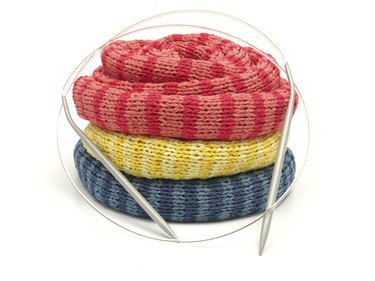
Circular knitting needles are really one long, double-ended needle; a flexible cable connects the butt ends of two short knitting needles. They're so named because they allow you to knit an unbroken circle, with none of the back-and-forth jockeying required when you use double-pointed needles. Longer circular needles are also the ideal tool for working on large non-circular or -tubular projects, such as afghans, that are knit all in one piece. A circular needle's length is the length of the entire needle, all the way from one needle tip to the other.
Measuring Circular Needles
Video of the Day
Circular needles don't lie flat easily on their own. The cable often either curls the needle tips inward or, on cheaper needles with plastic cables, the cable coils into spirals on its own. You can soften and straighten the cable by holding it over a bowl of steaming water or soaking it in warm water, but if you only need a measurement, there's really no need. Just lay a yard stick; pull the needle straight from end to end; and measure its length from tip to tip against the yard stick.
Video of the Day
Choosing the Right Circular Needle
Choosing the right length of circular needle for a project involves a certain amount of guesswork. Get it too short, and the stitches will be crammed so tightly together that they push each other off the ends of the needles; get it too long, and the stitches will be so tight on the cable that you won't be able to slide them around.
Pattern makers usually tell you exactly what length circular needle you need, but, if you're doing your own pattern, opt for needles that are slightly shorter than the finished circumference -- or length -- of your project. Here's a rough guide to help you choose the right needle length:
- 9- to 12-inch needles: socks, baby hats and sleeves on children's sweaters
- 16-inch needles: adult hats and the body of a child's sweater
- 24- to 29-inch needles: adult sweaters
- 29- to 32-inch needles: baby blankets, rugs and sweaters worked in pieces
- 36- to 60-inch needles: best for large projects like afghans
Using Circular Needles
Use circular needles in your knitting in one of two ways. The first is to simply knit back and forth, turning your work as usual. The cable between the needles works like a giant stitch holder, keeping everything tidy no matter which way you're working.
The second method is to join the ends of your knitted project into a continuous circle or tube; just cast on and keep working around the circle in the same direction instead of turning your work.
Alternatives to Circular Needles
If you don't have access to circular needles, you can use double-pointed needles for smaller projects, such as sweater sleeves or hats. You simply cast stitches onto each double-pointed needle in turn, linking them in an unbroken circle or tube and working around that circle just as you would with circular needles.
If you're working on a big project, such as an afghan, the easiest solution is usually working the project in pieces with a shorter straight needle, then seaming the pieces together once you're done.